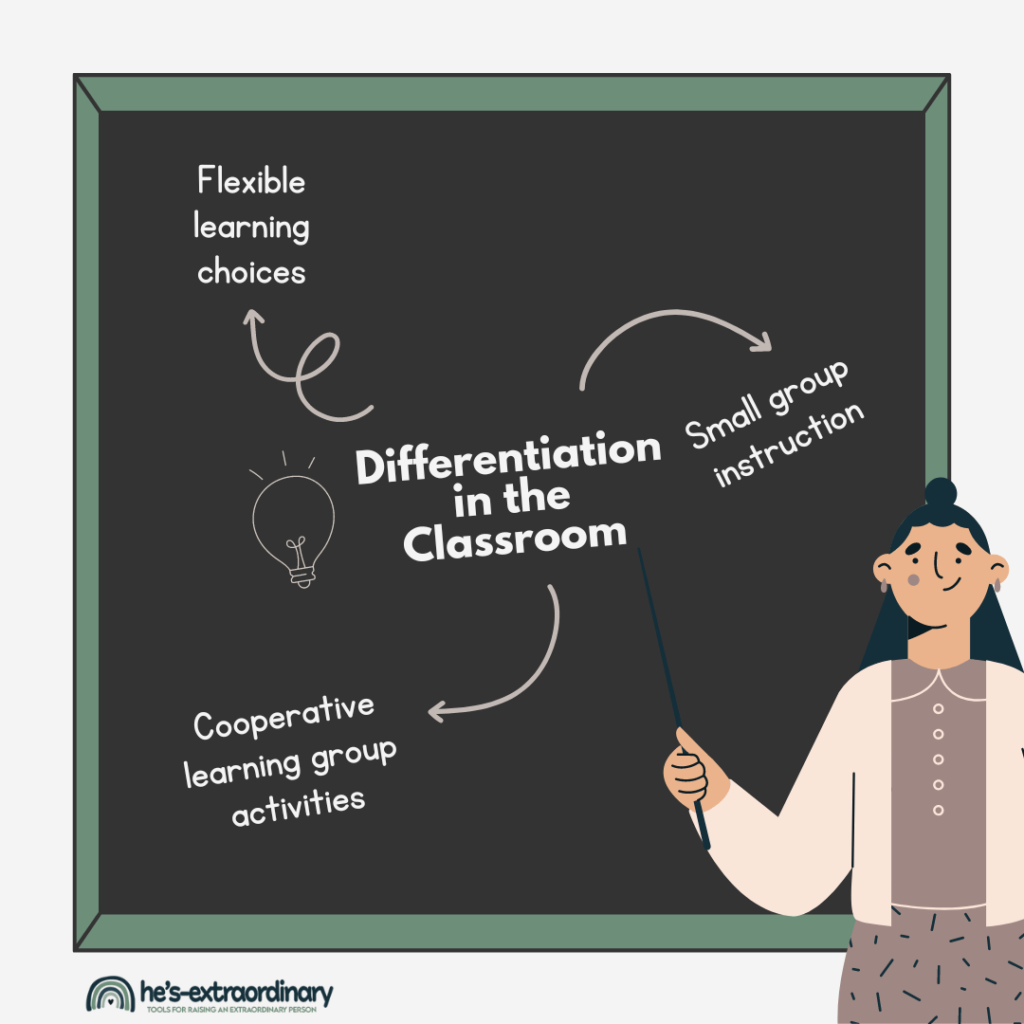Differentiation in the Classroom: Key Tips to Meet the Needs of Every Student
What’s inside this article: An introduction to differentiation in the classroom, includes strategies for implementing differentiation successfully, tips for educators working with students with autism and ADHD, and a look at how technology can help educators differentiate instruction.
As an elementary school teacher, you know that every child in your classroom is unique. They come from different backgrounds, have different learning styles, and have varying levels of prior knowledge.
So how can you meet the needs of all of your students while still delivering high-quality instruction? The answer lies in differentiation.
What is Differentiation in the Classroom?
In simple terms, differentiation in the classroom means adapting instruction to meet the diverse needs of all learners.
Students come to school with unique abilities, interests, and backgrounds, and all students are different. Therefore, it is essential to differentiate instruction to ensure that each student is challenged and engaged in their learning.
Why is Differentiation Important for All Learners?
According to a study by the Thomas B. Fordham Institute, students who receive differentiated instruction make more reading progress than those who receive traditional instruction.
Differentiation is important for all learners, regardless of their abilities, interests, or backgrounds. It promotes student engagement, motivation, and achievement.
By tailoring instruction to match students’ needs and interests, you can create a classroom environment where all students feel valued and supported.
Research also shows that differentiated instruction benefits students with learning disabilities. According to the National Center for Learning Disabilities, students with learning disabilities who received differentiated instruction improved their academic skills more so than those receiving traditional classroom instruction.
Differentiation also helps foster a growth mindset in learners, who understand that they can learn and grow through their efforts and the proper instructional support.
Strategies for Effective Differentiation in the Classroom
1. Provide Flexible Learning Choice
Offering flexible learning choices is an effective way to differentiate instruction in your classroom. Provide various options that allow students to select the materials and activities they find most interesting and engaging.
For example, a student who loves to read might choose to complete a comprehension activity related to a book, while another student who prefers hands-on projects may choose to participate in a STEM activity.
2. Use Small-Group Instruction
Small-group instruction is an excellent way to provide targeted support to individual learners. You can group students by skill level, interest, or learning style and provide instruction that meets their unique needs.
For example, in small reading groups, students with strong decoding skills might work with more challenging texts, while students who struggle with decoding might work on phonics or word recognition skills.
3. Incorporate Cooperative Learning Group Activities
Cooperative learning group activities promote collaboration and teamwork among students. When working in groups, students can learn from each other, share ideas, and support each other’s learning.
For example, in a math activity, students might work in pairs to solve a problem using manipulatives, or in a science activity, students might work together to conduct an experiment.

Differentiation Tips for Educators Working with Children with Autism or ADHD
Differentiating instruction for students with autism or ADHD requires additional considerations.
Here are five tips for successful differentiation in the classroom for educators working with children who have autism or ADHD:
Use visual aids to support learning:
Children with autism or ADHD may struggle with abstract concepts, so using visual aids can help them better understand the content. For example, using pictures, diagrams, and charts can help students with ADHD remember information better, while students with autism may benefit from visual schedules and social stories.
Incorporate sensory strategies:
Sensory strategies can help students with autism or ADHD stay focused and engaged in the learning process.
For example, allowing students to use fidget toys or providing brain breaks during instruction can help them stay calm and focused.
Provide clear expectations and routines:
Children with autism or ADHD may have difficulty with transitions and changes in routine, so providing clear expectations and routines can help them feel more secure and reduce anxiety.
For example, creating a visual schedule of the day’s activities can help students with autism or ADHD understand what to expect.
Provide opportunities for movement:
Students with ADHD may have difficulty sitting still for long periods, so providing opportunities for movement during instruction can help them stay focused.
For example, incorporating movement breaks or allowing students to stand while working can help them stay engaged in the learning process.
Offer flexible grouping:
Students with autism or ADHD may have different learning needs, so offering flexible grouping can help them receive the support they need to be successful.
For example, grouping students by ability or interest can help them work at their own pace and receive targeted instruction.
By implementing these tips, educators can create a classroom environment that is supportive and inclusive for all learners, including those with autism or ADHD. Students with these learning differences can thrive and reach their full potential by providing these strategies.

Using Technology to Differentiate Instruction
Technology has revolutionized how we approach education, and it’s another way to enhance differentiation in the classroom to meet the needs of all learners.
- Educational apps and games can provide individualized learning experiences for students.
- Online assessments can help teachers identify areas where students are struggling and provide targeted interventions.
- Visual and auditory aids such as videos, pictures, and audio recordings can help students understand complex concepts and instructions better.
- Learning management systems (LMS) like Google Classroom allow teachers to create differentiated assignments and activities for students based on their individual needs and abilities.
- Technology can help meet the diverse needs of all learners, including those with autism and ADHD.
In conclusion, differentiation in the classroom is necessary for every educator who wants to create a classroom environment where all learners can thrive.
By implementing strategies that work for your diverse classroom, you promote learning for all your students.
So, keep the above tips in mind and create a classroom where all students feel valued, respected, and engaged in their learning.
If you’re facing obstacles while trying to implement differentiation, read 5 Common Obstacles in Differentiation & How to Overcome Them

